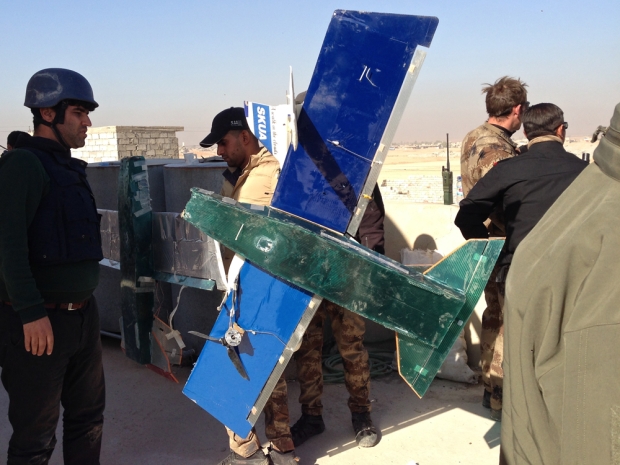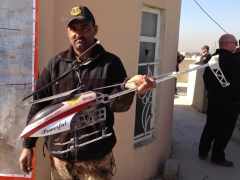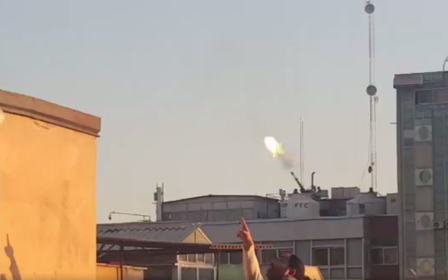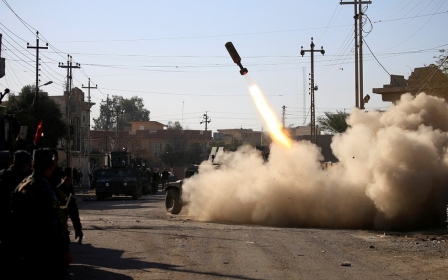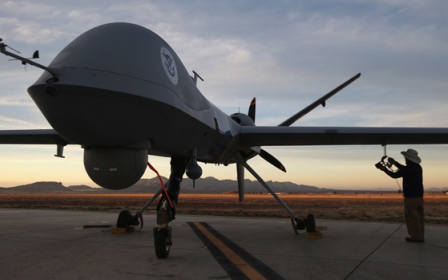Death from above: IS drones strike terror in 'safe' areas of Mosul

MOSUL, Iraq - Mohammed sits in his home in a liberated area of eastern Mosul, but still fears to go into the streets. Islamic State (IS) militants may have left, but their ability to inflict pain and terror remains very real.
A new threat hangs above those who survived two and a half years of brutal rule - ever more sophisticated drone aircraft sent from the group's western stronghold, which kill and maim indiscriminately.
"The drones come every day now, on some days every two to three hours," the 19-year-old told Middle East Eye.
"Yesterday my neighbour's wife was clearing out the garage when a grenade fell from an IS drone. She got a lot of shrapnel in her legs and the doctors say they might have to amputate."
From the outset of the Iraqi army's offensive to liberate the city, IS has deployed basic drones - cameras attached to remote-controlled aircraft - to identify army positions.
But as the conflict has progressed, the militants have refined their techniques for arming drones with mortar rounds, grenades and IEDs - and now use them as a principal weapon of war.
Mohammed said these relentless aerial attacks had plunged east Mosul residents back into a similar state of fear they had endured for two and a half years under IS rule.
"We are living in constant terror and are afraid to leave our homes. We only go outside now for essentials, like getting food or medicine," he said.
"You can't leave the house without checking the sky every single second and, even if you hear one of the drones, you don't have time to run away because they are so fast."
Shrapnel wounds
After IS's withdrawal west across the Tigris river, suicide bomb attacks declined in the east as they became more difficult to execute. But drones have taken their place, and their reach is becoming ever longer.
"We are receiving at least 10 patients every day injured by these drone attacks," said Thaaer Sultan, a general surgeon at the al-Zahra hospital.
"Daesh's techniques are not very advanced and these drones carry only small bombs, so most of the injuries are not fatal, but they can be severe."
The most common injuries were multiple shrapnel wounds to the lower limbs, as the IEDs dropped from drones explode on crashing to the ground.
The casualties have put further strain on the city's already overwhelmed makeshift medical facilities, pulled together after most of Mosul's hospitals were destroyed by IS or left severely damaged by fighting.
In the last fortnight alone, medics have treated hundreds of civilians wounded by the drone-borne IEDs, suicide attacks by rogue IS militants hiding in eastern Mosul, and mortar shells that fall in areas along the eastern banks of the Tigris.
"Most of the injured are from districts near the river because the remote-controlled drones are launched from the west side and cannot fly long distances, and the mortars have limited range," Sultan said.
"But yesterday, drones reached our district, which is far from the river. After this, and a suicide bombing last week, we start to feel that nowhere in eastern Mosul is safe. It is still a war zone."
The drones fly so high they are hard to spot.
'We start to feel that nowhere in eastern Mosul is safe. It is still a war zone'
- Thaaer Sultan, general surgeon
Near Iraqi army positions, the first warning is usually a volley of gunfire as soldiers attempt to shoot down the tiny aircraft. In residential districts, the sinister buzz of a drone engine - often inaudible above the sound of generators which are still the only source of electricity for most homes - is usually followed by an explosion.
The Iraqi army have shot down and seized many drones, but soldiers say IS seems to have an unending supply of new aircraft.
IS's lack of airpower has proved to be a significant gap in their ongoing defence of its self-proclaimed "Caliphate" territories. During the Mosul conflict, they have been steadily refining their latest tactic of arming commercially available drones, transforming these into an effective aerial weapon.
In late January, IS released a slick video showing militants launching a fixed-wing drone out across the Tigris, its undercarriage armed with a pair of thin bombs, bound in electric tape and fitted with plastic fins.
Omar, an officer from the Iraqi army's Golden Division, said drone-borne IEDs were usually fitted into ordinary household plastic containers, such as liquid soap bottles.
"They cut off the ends and then cement or glue small mortar rounds inside, or [they use] large-calibre bullets filled with TNT and pieces of metal to act as shrapnel," he said. "They are basically air-dropped, impact-fused grenades."
In the rubble surrounding a bombed-out building once occupied by IS snipers lays an empty, carefully sliced open tube of DIY sealant lined with cement - the remains of a device that had inaccurately targeted a nearby Golden Division position.
"This was a small one," Omar said, kicking it aside in disgust.
Some IS fixed-wing drones are fitted with plastic cups on the top of their fuselage into which IEDs are slotted, according to Mohammed.
"When they see a group of people, they flip the drone upside down via the remote control and the bombs fall to the ground," he said.
In the IS video, edited aerial footage shows groups of military vehicles and soldiers being selected as targets, highlighting the path of the falling bombs and the impact of the subsequent explosions, felling personnel and sending others running for cover.
A military expert who watched the video told MEE that although the armed drones were relatively low-tech, the results were "surprisingly accurate and effective". He added that for decades, many weapons had been designed to maim rather than kill, as this ties up medics and comrades helping the wounded.
Although the IS video footage featured a new fixed-wing drone, in reality, many shot down in and around Mosul have been more battered examples, bound in glass-fibre tape to reinforce against repeated crash-landings.
IS also appears to be moving away from fixed-wing models, a cache of which were discovered in a Mosul drone workshop, stocked with self-assembly plastic and styrofoam components.
These had been a progression from earlier IS attempts, seemingly abandoned, to fashion their own drones from scratch in other areas of Iraq. Omar said IS was now favouring rotor-propelled "quad drones" for their IEDs.
"When they identify a target, they swivel the camera underneath, which hangs off-centre, and this action knocks and releases the IED," he said. "The results are not exact but they are getting more accurate."
Some Golden Division units have now started acquiring their own quad drones to boost surveillance efforts.
Daesh in the skies
IS have also deployed drones on the frontlines beyond Mosul. On the outskirts of Kirkuk, 170km southeast of Mosul, Peshmerga military commander Kermal Kirkuki proudly showed a new Talon X-UAV drone, manufactured by the Chinese Hooah Aviation firm, which now stands in a corner of his office.
The unarmed aircraft - fitted with two cameras, including a Hero4 GoPro - was seized by his forces near the Kirkuk frontline late last year.
"We have researched this drone and found that it was made in China but bought in Europe," he said. "The operator, who we later killed, was a British citizen."
And to the west of Mosul, during the battle for Tal Afar airport led by Iraq's Popular Mobilisation Units, three armed drones were shot down in two days.
Commanders said that IS continues to relentlessly deploy armed drones at the PMU's westernmost frontline, where forces are fighting to close IS's last remaining escape and supply route between Iraq and Syria.
The pace at which IS has developed and refined techniques for deploying drone-borne IEDs has even prompted Operation Inherent Resolve - the US-led coalition supporting Iraq's battle against IS - to change its tune.
In November last year, a spokesman dismissed IS drones as "not having any strategic importance".
But, at a briefing on 15 February, the operation's deputy commander, Major General Rupert Jones, admitted they were "becoming an increasingly insidious threat in Iraq".
"The thing that is most concerning is that they are being used increasingly to drop grenades and other explosive munitions on the innocent civilians in east Mosul and elsewhere."
Jones insisted IS drone weapons were not a "game changer" and that coalition forces had technical defences against them.
However, until such defences are more comprehensively deployed, Iraqi army units continue to try to down IS drones with rifles and machine guns, and east Mosul residents still scan the skies in terror.
Middle East Eye propose une couverture et une analyse indépendantes et incomparables du Moyen-Orient, de l’Afrique du Nord et d’autres régions du monde. Pour en savoir plus sur la reprise de ce contenu et les frais qui s’appliquent, veuillez remplir ce formulaire [en anglais]. Pour en savoir plus sur MEE, cliquez ici [en anglais].




